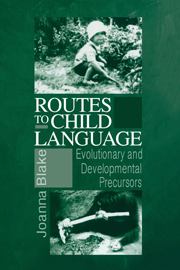Book contents
- Frontmatter
- Contents
- Preface
- 1 Prelinguistic Vocalizations
- 2 Sound–Meaning Correspondences
- 3 Communicative Gestures
- 4 Symbolic Gestures and Symbolic Play
- 5 Tool Use and Object Concept
- 6 Representation in Human Infants
- 7 Memory in Nonhuman Primates and Young Children
- 8 Origins of Language
- 9 Recapitulation
- References
- Index
7 - Memory in Nonhuman Primates and Young Children
Published online by Cambridge University Press: 12 January 2010
- Frontmatter
- Contents
- Preface
- 1 Prelinguistic Vocalizations
- 2 Sound–Meaning Correspondences
- 3 Communicative Gestures
- 4 Symbolic Gestures and Symbolic Play
- 5 Tool Use and Object Concept
- 6 Representation in Human Infants
- 7 Memory in Nonhuman Primates and Young Children
- 8 Origins of Language
- 9 Recapitulation
- References
- Index
Summary
“Of all the prerequisites for language, none is more vital, though more easily overlooked than memory; yet language is possible only because of memory … [or rather the] representation of the objects, actions, or properties stored in memory” (Premack, 1978, p. 877). All researchers agree that recognition memory is a primitive form of memory available to quite simple animals and to very young infants. It is, rather, recall memory that is important for language acquisition. Recall is defined as “accessing (bringing to awareness) information about something that is not perceptually present. By definition, recall is a conscious product” (Mandler, 1990, p. 486). In the previous chapter, I focused on the development of representational processes in infancy that are basic to recall. In this chapter, I focus on the relationship between recall memory and language acquisition. I begin by examining memory in nonhuman primates – not only recall memory but also recognition memory involving representation of a sequence or array. These aspects of nonhuman primate recognition memory are included because sequential memory appears to have important implications for children's acquisition of language.
Memory in Monkeys and Apes
Most of the recent research on memory in nonhuman primates involves experiments with captive monkeys, with research on captive apes largely limited to early studies. However, some evidence exists on spatial memory in both wild and captive apes and on delayed imitation in rehabilitant apes.
- Type
- Chapter
- Information
- Routes to Child LanguageEvolutionary and Developmental Precursors, pp. 186 - 212Publisher: Cambridge University PressPrint publication year: 2000



